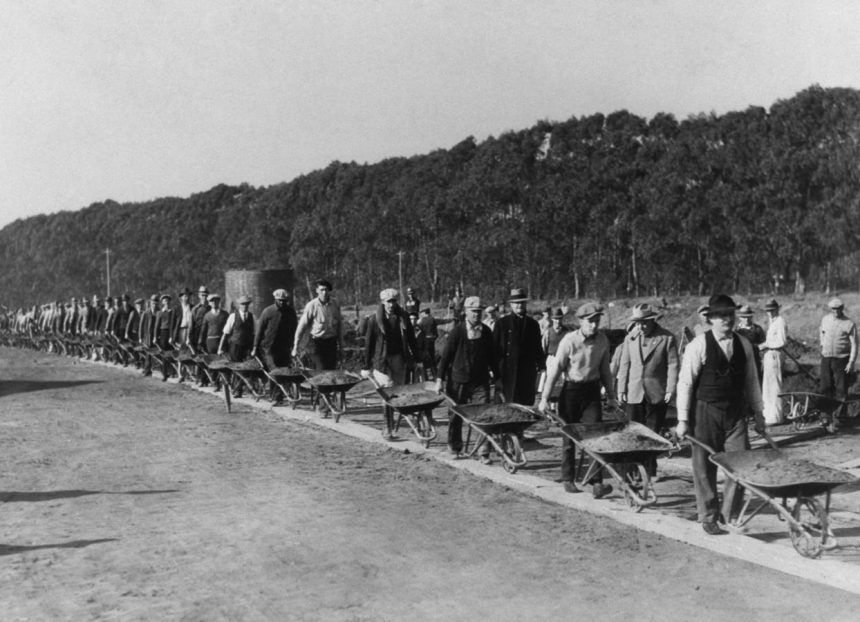Keynesian economics, popularized by John Maynard Keynes during the Great Depression, posits that government spending can stimulate a struggling economy. The core concept is the “multiplier effect,” where government funds injected into the economy circulate through spending, creating a ripple effect of increased economic activity. In essence, the theory suggests that even unproductive government spending can boost the economy by increasing demand. However, a closer examination of the economic data from the 1930s and 40s raises serious questions about the efficacy of Keynesian policies during that period.
The 1930s, the era of the New Deal, offers a stark contrast to Keynesian predictions. Despite significant government spending, economic growth remained stagnant. From 1929 to 1940, the private sector grew at a meager 0.7% annually, a far cry from the typical 4-6% growth experienced previously. While proponents might argue that the New Deal prevented a complete economic collapse, the data suggests the multiplier effect was negligible, if not negative. The government’s focus on public works projects, such as post office murals and dams, failed to generate substantial private sector growth. This lack of private sector expansion, despite increased government spending, directly contradicts the central tenet of Keynesianism. The intended stimulus seemingly failed to ignite a chain reaction of increased demand and production.
The argument that the New Deal pulled the economy out of its trough in 1933 also faces scrutiny. While there was some recovery between 1933 and 1937, it paled in comparison to the pre-Depression growth trajectory. Even with several years of New Deal programs, the economy never regained its former vigor. One might expect a robust recovery from such a low point, regardless of government intervention. Attributing the modest recovery solely to Keynesian policies ignores other factors and the basic principle of regression to the mean. Furthermore, the subsequent dip in 1938 casts further doubt on the sustained effectiveness of the New Deal stimulus.
The focus on per capita growth further weakens the Keynesian argument. Population growth slowed considerably during the 1930s. When adjusted for this demographic shift, the apparent economic gains of the New Deal become even less impressive. The claim that Keynesian policies were responsible for economic recovery loses its weight when viewed through the lens of per capita growth. The limited growth achieved appears even more insignificant when considering the potential for individual economic improvement.
Even the increased defense spending in the late 1930s and 1940s provides little support for the multiplier effect. While overall GDP increased, GDP excluding defense spending actually declined after 1940. This suggests that the observed growth was primarily driven by military expenditure, not a broader, self-sustaining economic expansion. The lack of a spillover effect into the non-defense sectors again challenges the validity of the multiplier effect. The intended ripple effect into the broader economy seemingly failed to materialize.
Perhaps the most striking contradiction to Keynesian theory lies in the post-World War II economic boom. As government spending dramatically decreased from wartime levels, the American economy experienced unprecedented growth. This period of prosperity coincided with a substantial reduction in government intervention, the very opposite of what Keynesianism prescribes. The economic surge occurred as government spending fell from 43% to 11% of GDP, indicating a strong correlation between reduced government involvement and increased private sector growth.
The defense of Keynesianism often requires complex and lengthy explanations. Stephen Marglin’s recent book, “Raising Keynes: A Twenty-First Century General Theory,” serves as a case in point. The book’s considerable length and acknowledged complexity suggest that defending Keynesian principles requires intricate arguments and nuanced interpretations. This complexity stands in contrast to the relatively straightforward tenets of the theory itself, raising questions about the clarity and empirical support for its core principles. The necessity of such extensive justification perhaps indicates underlying weaknesses in the theory’s ability to explain real-world economic phenomena, particularly the observations from the 1930s and 1940s.



